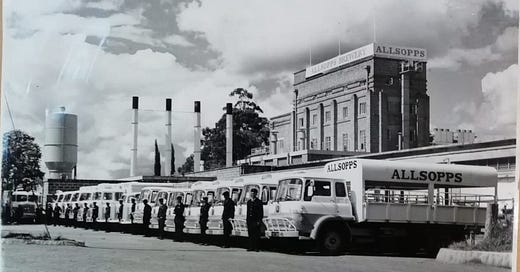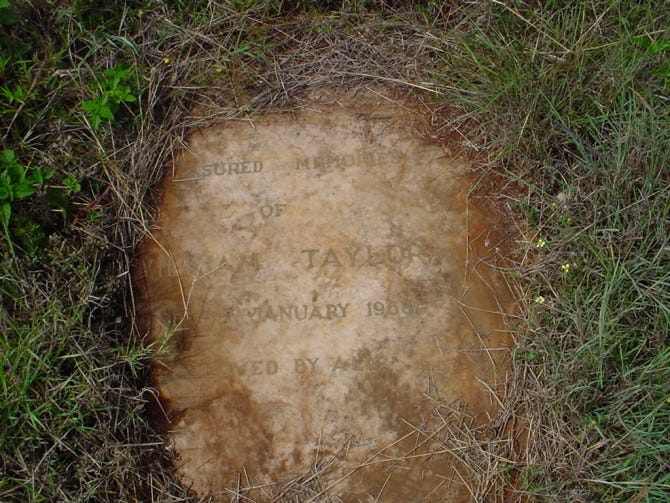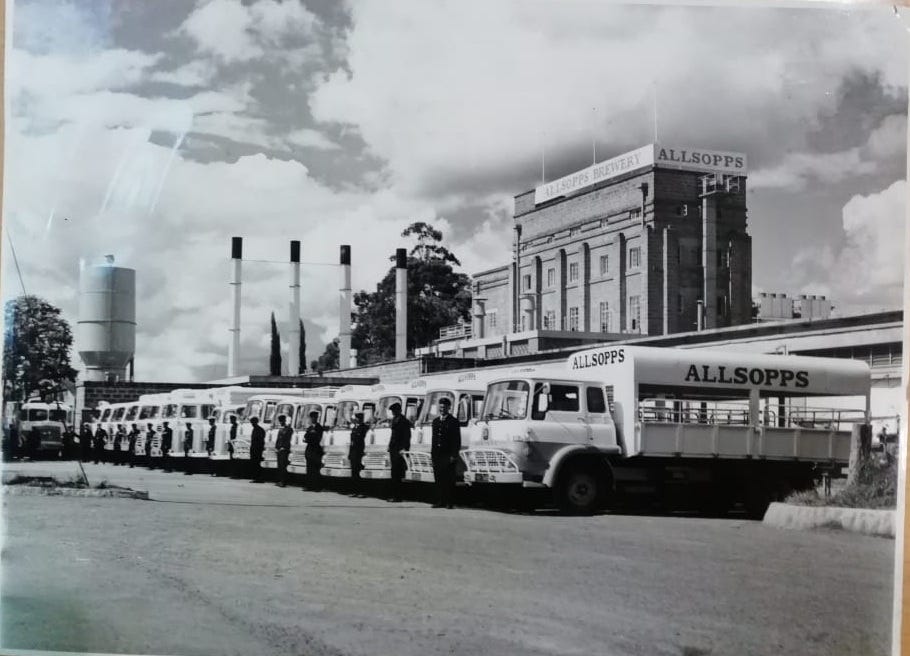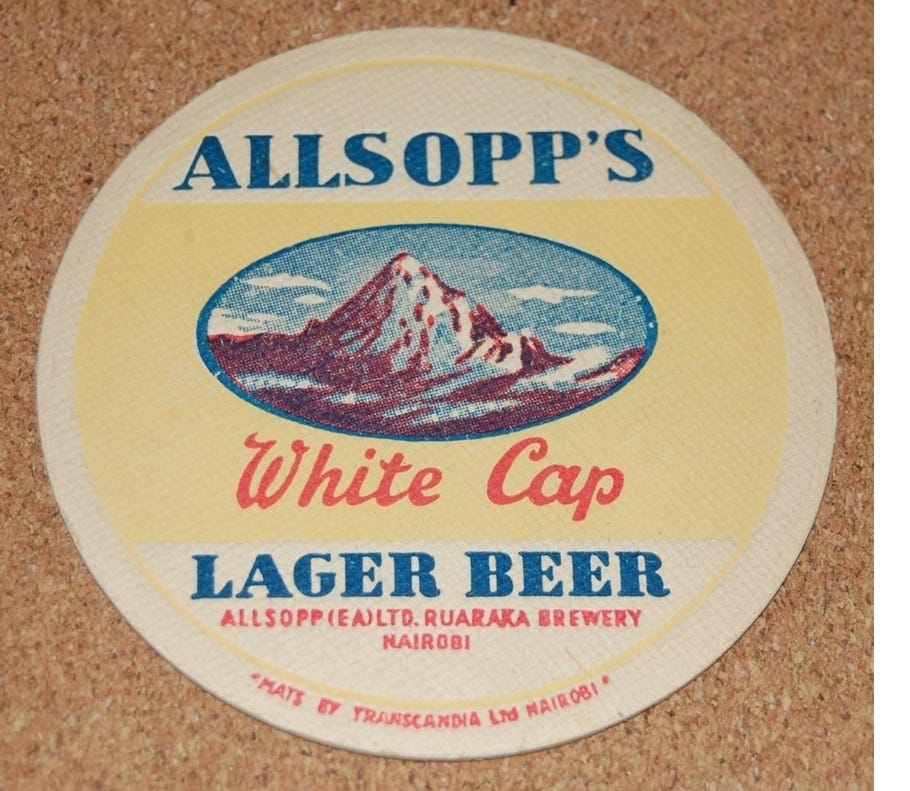Allsopps, the Kenyan brewery that fell flat
Bill Taylor's grave is neglected as well and hardly noticed
Bill Taylor’s grave at Lang’ata Cemetery is unremarkable—just another slab of stone among countless others, offering no hint of the empire he once built. Yet, in his heyday, Taylor was a brewing mogul, a name synonymous with Kenya’s beer industry.
His Allsopps Brewery (below, which once stood proudly opposite today’s General Service Unit headquarters along what is now Thika Superhighway, was more than just a factory. It was a towering landmark, a gateway that signaled all villagers arrival in Nairobi. For years, its chimneys puffed into the city skyline. Today, both the man and his empire are gone.
This brewery was the birthplace of Allsopps Pilsner and White Cap—names etched into Kenya’s beer folklore.
For years, its ruins, weathered by time, overlooked the valley where it all began. What could have been preserved as part of Kenya’s brewing heritage—a beer museum or a relic of industrialization—stood in silent neglect. Then the bulldozers came, clearing the site for the expansion of the GSU intersection. The brewery vanished. Only memories remain.
Constructed in 1938 under the name Taylor and Company Brewery, this establishment emerged as a formidable competitor to Kenya Breweries—founded in 1922 by the Hurst brothers, George and Charles, who abandoned their farming ventures in Kitale to stake their future on beer. The man behind Allsopps, William Taylor, was no ordinary entrepreneur; he had once steered East African Breweries Limited (EABL) as its managing director from 1931 to 1938. Under his tenure, bottled beer was first pasteurized in 1924, and he played a critical role in popularizing the iconic Tusker lager, a legacy that endures to this day.
Yet fate conspired against Taylor’s ambitions. A mere year after he unveiled his brewery, the Second World War erupted, choking the supply of raw materials. Although the conflict brought an influx of thirsty soldiers, their beer rations were strictly capped at two bottles per week, stifling the brewery’s prospects. The war's end ushered in a glimmer of hope, with British authorities promising to settle demobilized soldiers in Kenya—a promise that ultimately faltered, leaving the brewing industry saddled with overproduction
A seismic shift in 1947 proved pivotal: indigenous Kenyans were, for the first time, legally permitted to consume and trade bottled beer. This came after Attorney General J. Basil Hobson amended the 1934 Liquor Ordinance, granting Africans, Abyssinians, Somalis, Malagasy, and Comoro Islanders access to licensed liquor sales. This newfound opportunity birthed future beer moguls like Njenga Karume, who, in 1948, opened his first bar in Kiambu, setting him on a path to immense wealth.
While EABL teetered on financial ruin, Taylor’s venture fared no better. By 1951, after thirteen years of struggle, he relinquished control, selling his stake to Ind Coope and Allsopp (East Africa) Limited. This marked the beginning of a brewing dynasty, as the company, having acquired a 49% stake in Taylor and Company three years prior, now introduced Pilsner and White Cap to the East African market, shaking EABL’s dominance. The expansion of the Ruaraka brewery was emblematic of Britain’s post-war economic revival, with Allsopps diversifying into soft drinks in collaboration with Schweppes East Africa—long before Coca-Cola entered the scene
.
Yet, turbulence loomed. The 1953 declaration of a State of Emergency in response to the Mau Mau uprising plunged the brewery into financial turmoil. Although it recovered in 1961, the writing was on the wall. In 1962, EABL made a decisive move, acquiring Allsopps (East Africa) Ltd, amalgamating it into the East African Breweries Group, and assimilating its brands—including the revered Allsopps Pilsner—into its portfolio. By independence in 1963, the brewery had embarked on yet another expansion, pouring £150,000 into its future.
Such was the brewery’s confidence in its brand that it orchestrated a dramatic publicity stunt: a bottle of Pilsner was loaded into the fuselage of the Supersonic Scimitar, set to fly down Mombasa Road from Embakasi, testing whether it would taste just as exquisite after breaking the sound barrier.
Long before Allsopps, it was the Hurst brothers who first saw the potential in Ruaraka. In 1922, they established Kenya’s inaugural brewery on the banks of Rui-Rwa-Aka, the pristine river whose name, meaning ‘women’s river’ in Kikuyu, was later corrupted to Ruaraka. The Hursts had not come to Kenya to brew beer; their initial foray into gold prospecting proved disastrous, nearly bankrupting them. Flax farming failed, coffee crops succumbed to hailstorms, and Ruaraka became their final gamble.
George Hurst, an enthusiastic socialite, found inspiration at Nairobi’s New Stanley and Norfolk hotels, where he mingled with failed farmers, war veterans, and intrepid businessmen. At one such gathering, marking the end of the First World War, he observed a glaring anomaly—imported beer, shipped over 6,000 miles, dominated the toasts. An idea was born. Over drinks, he pitched the notion to his brother Charles and their friend H.A. Dowding. The trio pooled £2,500 each and scouted for a location. Ruaraka, with its unspoiled river and rolling landscapes teeming with wildlife, was their chosen ground.
Charles set sail for England, procured brewing equipment, and shipped it to Mombasa. The rest, as they say, is history.
Among those who once toiled in that brewery was none other than William Taylor—the man who later built the doomed Allsopps Brewery. Today, Taylor’s dreams and its ruins exist in the White Cup and the Pilsner – the two brands that were part of ruins, one truth remains immutable: Allsopps Brewery.
Taylor died in 1968 and was buried in the Langata cemetery.








Informative.JK,you never disappoint.
Apart from the tangle of roads and pedestrian bridges, I have been wondering what is different about Allsopps, as the location is called… now that you mention it the rectangular 3-storey dark masonry building is no longer there…